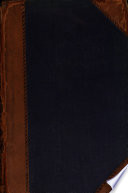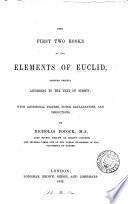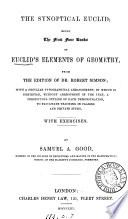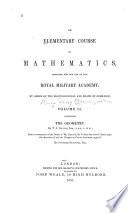 | Francis James Jameson - 1851 - 144 sider
...= 4 (ABa + AC2) + 4AE2 + 4AF2, = 4BC2 + AB2 + AC2, = 4BC2 + BC2, - 5BC8. 1849. (A). Divide a given straight line into two parts, so that the rectangle contained by the whole and one of the parts shall be equal to the square of the other part. (ii. 11.) (B). Shew that in Euclid's figure, four other... | |
 | Harvey Goodwin - 1851 - 196 sider
...homogeneity of algebraical equations, or any demonstration other than Euclid's ? 3. Divide a given straight line into two parts, so that the rectangle contained by the whole and one of the parts shall be equal to the square of the other part. Shew that in Euclid's figure four other lines, beside... | |
 | 582 sider
...Enumerate tlie cases proved in Book 1 and state what ease is omitted. SECTION IT. 1. Divide a given straight line into two parts, so that the rectangle contained by the whole and one of the parts, shall be equal to the square of the other part. 2. If a straight line be divided into any two parts,... | |
 | John Radford Young - 1851 - 266 sider
...is 41, and the sum of whose squares is 901. (7) Divide 20 into two parts, such that the product of the whole and one of the parts may be equal to the square of the other part. (8) A person bought a certain number of sheep for £60 ; and having reserved 15,... | |
 | University of Durham - 1851 - 222 sider
...twice the rectangle contained by the parts. 5. To divide a given straight line into two parts, such that the rectangle contained by the whole and one of the parts shall be equal to the square of the other part. 6. If two circles cut one another they cannot have... | |
 | Euclides - 1852 - 152 sider
...(25). These two Propositions may be omitted at the first reading.] PEOP. XL PROB. To divide a given straight line into two parts, so that the rectangle contained by the whole, and one of the parts, shall be equal to the square of the other part. Let AB be the given straight line ; it is required... | |
 | Bengal council of educ - 1852 - 348 sider
...contain the right angle. Is this proposition included in any more general one ? (2.) To divide a given straight line into two parts, so that the rectangle contained by the whole and one of the parts, shall be equal to the square of the other part. Can this be solved arithmetically ? if so, find approximately... | |
 | Charles Astor Bristed - 1852 - 470 sider
...every triangle are equal to two right angles. 3. Divide a given straight line into two such parts, that the rectangle contained by the whole and one of the parts shall be equal to the square of the other part. 4. The angle at the centre of a circle is double of... | |
 | Euclides - 1853 - 146 sider
...squares of AC, CD. Wherefore, if a straight line, &c. QED PROP. XI. — PROBLEM. To divide a given straight line into two parts, so that the rectangle contained by the whole and one of the parts, shall be equal to the square of the other part. Let AB be the given straight line ; it is required... | |
 | Royal Military Academy, Woolwich - 1853 - 400 sider
...squares of AC, CD. Wherefore, if a straight line, etc. QED PROPOSITION XI. PROB. To divide a given straight line into two parts, so that the rectangle contained by the whole, and one of the parts, shall be equal to the square of the other part. Upon AB describe (46. i.) the square ABDC ; bisect... | |
| |